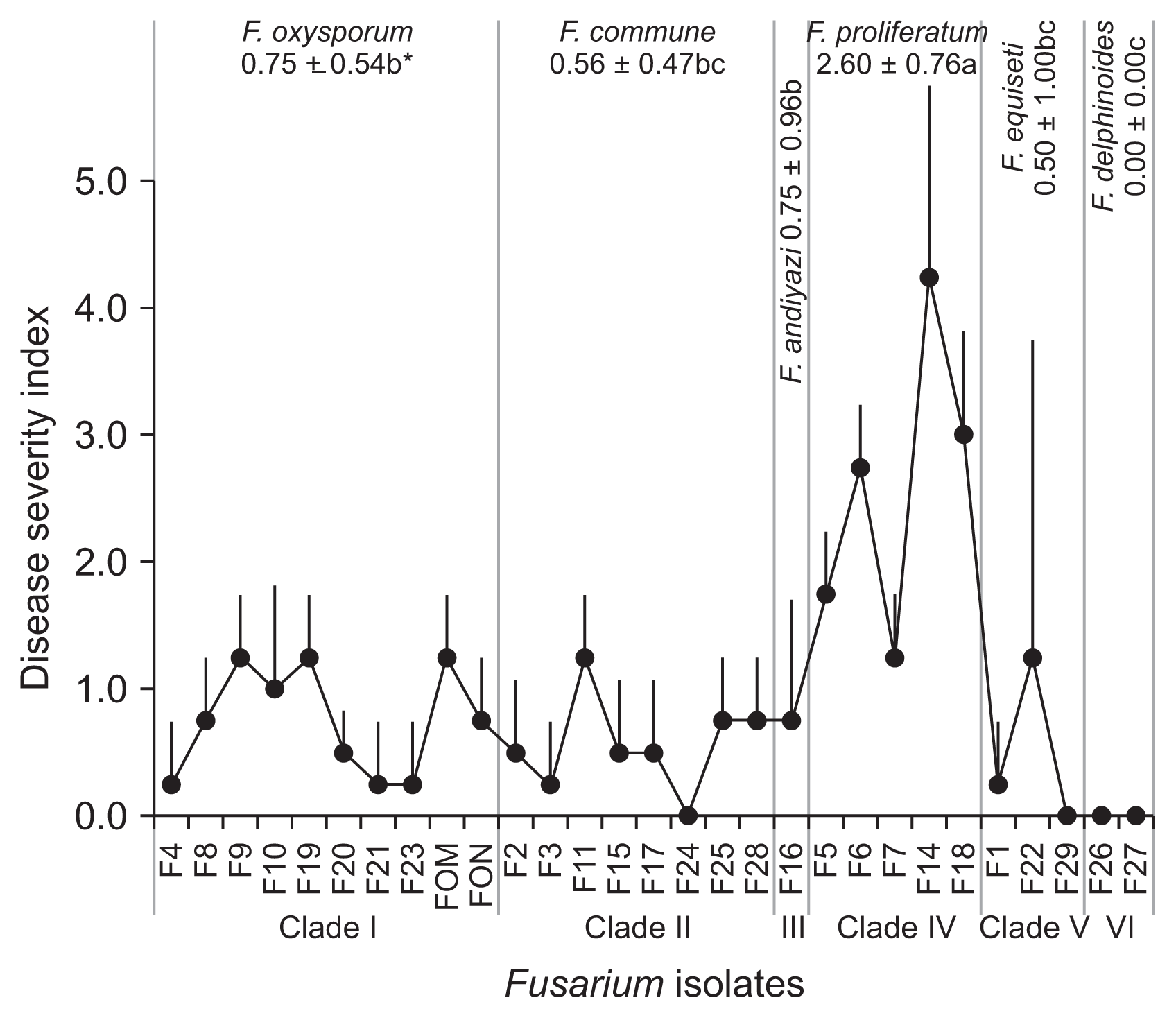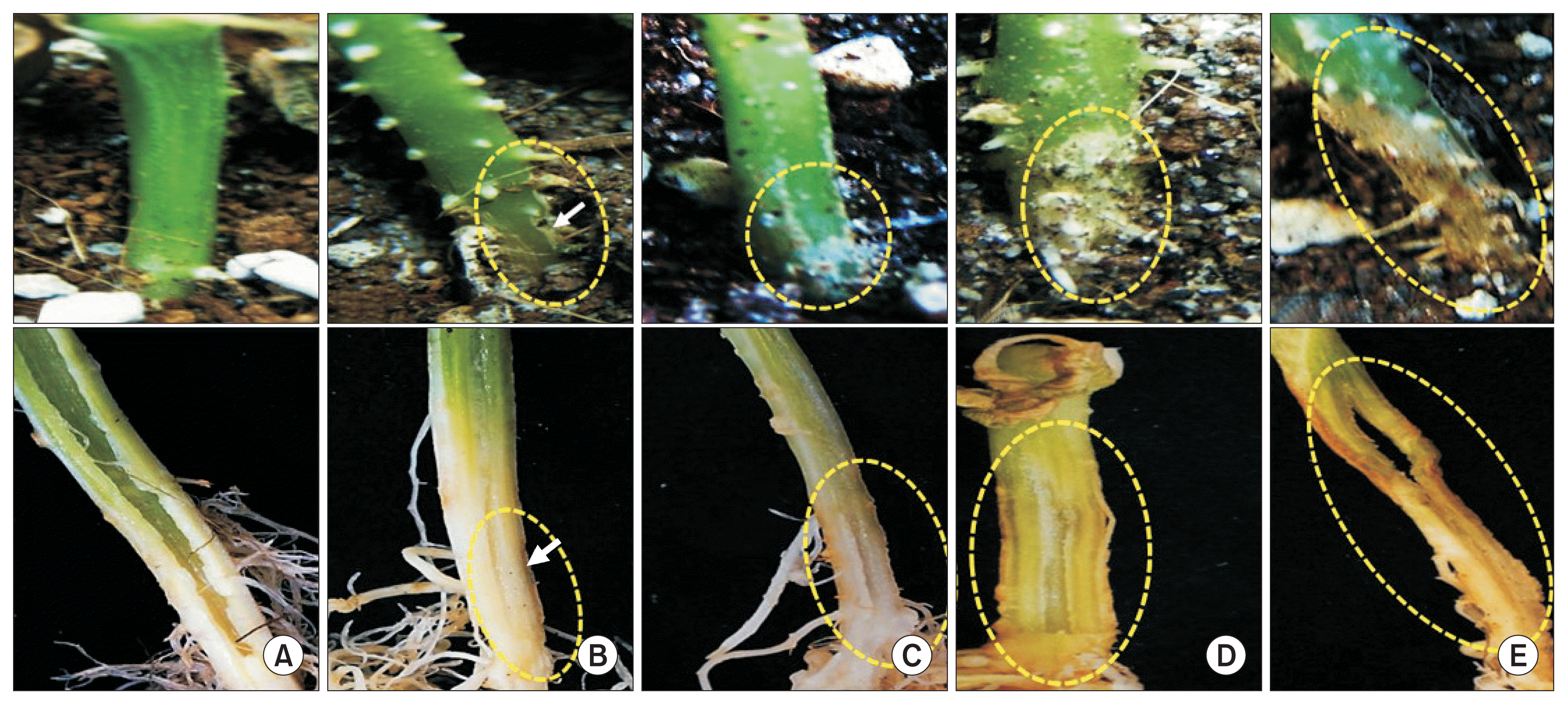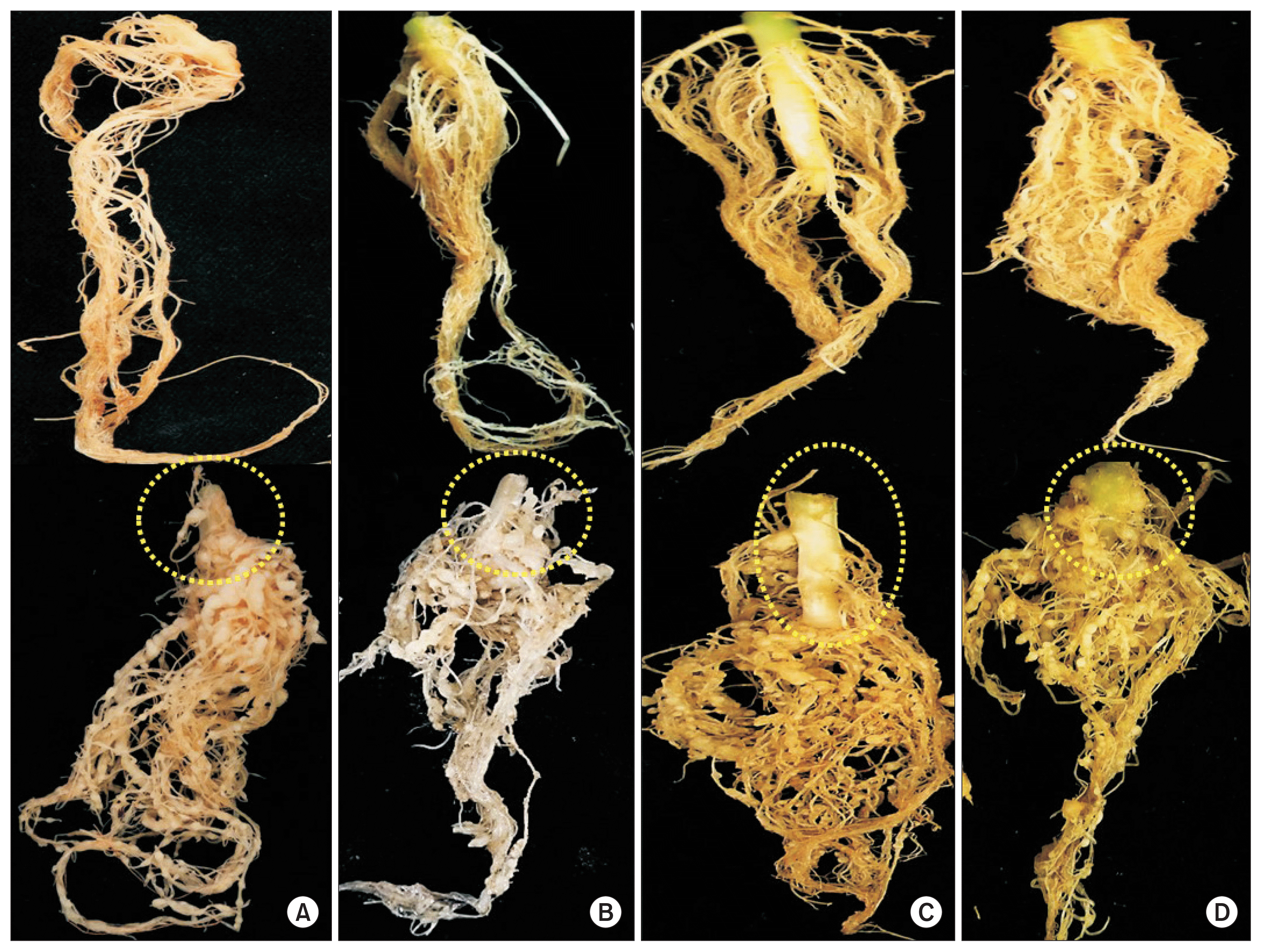 |
 |
| Plant Pathol J > Volume 33(3); 2017 > Article |
Abstract
Fig.┬Ā1

Fig.┬Ā2

Fig.┬Ā3

Fig.┬Ā4

Fig.┬Ā5

Fig.┬Ā6

Table┬Ā1
| Isolation area* | Isolate | Morphological characteristic | Identification ┬Č | Most identical GenBank accession no. | ||||||
|---|---|---|---|---|---|---|---|---|---|---|
|
|
|
|||||||||
| Pigment | MicroconidiaŌĆĀ | Chlamy dosporeŌĆĪ | Macroconidia | EF-1╬▒ | ITS | |||||
|
|
||||||||||
| No. of septa | Apical cell┬¦ | Basal cell|| | ||||||||
| SB | F4 | Orange | E, O | R, S | 2-3 | T | F | F. oxysporum | KT005896.1 | KU984712.1 |
| YI | F8 | Violet | E, O | S | 3 | C | F | KU128954.1 | KU872840.1 | |
| YG | F9 | Violet | E, O | S | 2-3 | T | F | KP761170.1 | KU195688.1 | |
| YI | F10 | Orange | E, K, O | S | 3 | T | F | KT794174.1 | KU195687.1 | |
| SJ | F19 | Violet | E, O | R | 2-3 | C | F | KT006896.1 | KU931554.1 | |
| SJ | F20 | Violet | E, O | S | 3 | TC | F | JF740824.1 | KU097256.1 | |
| SY | F21 | Orange | E, O | S | 3 | TC | F | KJ920413.1 | KU195686.1 | |
| SB | F23 | Violet | E | R | 3 | TC | SC | KT884662.1 | KU984712.1 | |
| SY | F2 | Violet | E, O | S | 2 | SC | F | F. commune | KU341327.1 | KT982281.1 |
| SB | F3 | Violet | E | S | 1-3 | SC | F | KU341327.1 | KT982281.1 | |
| YD | F11 | Orange | E | S | 1-3 | SC | F | KU341325.1 | KU341324.1 | |
| SB | F15 | Violet | E | S | 1-3 | SC | F | JX289893.1 | KT982280.1 | |
| SW | F17 | Orange | E | R, S | 1-3 | SC | F | KP868559.1 | KU341323.1 | |
| SJ | F24 | Pale orange | E | S | 2-3 | SC | F | KC430630.1 | KU341324.1 | |
| SY | F25 | Violet | E, O | S | 3 | SC | F | KP868659.1 | KT982281.1 | |
| SW | F28 | Orange | E, O | S | 2-3 | SC | F | KP868659.1 | KU341424.1 | |
| YI | F5 | Violet | E | nd | 3-5 | C | Pd | F. proliferatum | KU847810.1 | KP267107.1 |
| YD | F6 | Greyish orange | E, O | nd | 3 | C | Pd | KM462980.1 | KT803067.1 | |
| YI | F7 | Orange | E | nd | 3 | C | Pd | KP9649061 | KP267107.1 | |
| SW | F14 | Violet | E | nd | 3 | C | Pd | KP9649061 | KP267107.1 | |
| SY | F18 | Violet | E, O | nd | 2-3 | C | Pd | KP964907.1 | KT462721.1 | |
| SY | F1 | Pale orange | nd | Cl | 3 | TE | PF | F. equiseti | KP267226.1 | KU041860.1 |
| SJ | F22 | Orange | nd | Ch, Cl | 3 | TE | PF | DQ842087.1 | KU041860.1 | |
| SY | F29 | Orange | nd | Ch | 5 | TE | PF | FJ895283.1 | KU041860.1 | |
| SJ | F26 | Orange | S | Ch | 3 | C | S | F. delphinoides | AB817172.1 | KU296244.1 |
| SW | F27 | Orange | S | Ch | 2 | C | S | EU926292.1 | KU296244.1 | |
| SY | F16 | Dark pink | E | nd | 3 | SC | P | F. andiyazi | KT257545.1 | KP245748.1 |
| ŌĆāFOM** | Violet | E, K, O | S | 3 | T | F | F. oxysporum f. sp. melonis | |||
| ŌĆāFON | Violet | E, O | S | 3 | T | F | F. oxysporum f. sp. niveum | |||
* Isolation areas: Seongju-gun, Byeokjin-myeon (SB), Jocheon-myeon (SJ), Yongam-myeon (SY), Wolhyang-myeon (SW); Yeoju-gun, Ipo-ri (YI), Gyesan-ri (YG), Daesin-ri (YD).
|| F, foot shaped; SC, slightly curved; Pd, poorly developed; PF, prominently foot shape; P, pedicillate.
┬Č References: Leslie and Summerell (2006) for F. oxysporum, F. proliferatum, and F. equiseti; Skovgaard et al. (2003) for F. commune; Schroers et al. (2009) for F. delphinoides; and Marasas et al. (2001) for F. andiyazi.
Table┬Ā2
| Sub clade* | IsolateŌĆĀ | Disease indexŌĆĪ | |||||||||
|---|---|---|---|---|---|---|---|---|---|---|---|
|
|
|||||||||||
| Watermelon | Oriental melon | Shintosa | Cucumber | Total | |||||||
| 1 | F10 | 0.75 ┬▒ 0.89ab┬¦X|| | 0.97 ┬▒ 0.85aX | 0.75 ┬▒ 0.71cdX | 0.91 ┬▒ 0.62aXY | 0.88 ┬▒ 0.71aX | 0.63 ┬▒ 0.54abYZ | 0.63 ┬▒ 0.52bcdX | 0.50 ┬▒ 0.51bZ | 0.75 ┬▒ 0.69ab | 0.96 ┬▒ 0.75a |
| F21 | 0.38 ┬▒ 0.52bX | 0.25 ┬▒ 0.46dX | 0.25 ┬▒ 0.46cdX | 0.13 ┬▒ 0.35eX | 0.25 ┬▒ 0.45c | ||||||
| FOM | 1.38 ┬▒ 1.06aX | 1.75 ┬▒ 0.46aX | 0.38 ┬▒ 0.46bcdY | 0.38 ┬▒ 0.52deY | 0.97 ┬▒ 0.64a | ||||||
| FON | 1.38 ┬▒ 0.92aX | 0.88 ┬▒ 0.83cX | 1.00 ┬▒ 0.83aX | 0.88 ┬▒ 0.64abcX | 1.03 ┬▒ 0.73a | ||||||
| 2 | F4 | 1.00 ┬▒ 0.763abY | 0.92 ┬▒ 0.78aX | 1.75 ┬▒ 1.49aX | 1.17 ┬▒ 0.96aX | 0.63 ┬▒ 1.49aYZ | 0.25 ┬▒ 0.29bY | 0.50 ┬▒ 0.53cdeZ | 0.25 ┬▒ 0.41bY | 0.97 ┬▒ 0.82a | 0.56 ┬▒ 0.69b |
| F19 | 0.75 ┬▒ 1.04abXY | 1.13 ┬▒ 0.64bcX | 0.00 ┬▒ 0.00dZ | 0.13 ┬▒ 0.35eYZ | 0.50 ┬▒ 0.51bc | ||||||
| F23 | 1.00 ┬▒ 0.53abX | 0.63 ┬▒ 0.74cdXY | 0.13 ┬▒ 0.74dY | 0.13 ┬▒ 0.35eY | 0.47 ┬▒ 0.50bc | ||||||
| 3 | F20 | 1.00 ┬▒ 0.76abX | 1.00 ┬▒ 0.76aX | 0.88 ┬▒ 0.64cX | 0.88 ┬▒ 0.64aXY | 0.63 ┬▒ 0.64abcX | 0.63 ┬▒ 0.74abYZ | 0.38 ┬▒ 0.52deX | 0.38 ┬▒ 0.52bZ | 0.72 ┬▒ 0.68a | 0.72 ┬▒ 0.68ab |
| 4 | F8 | 0.88 ┬▒ 0.35abX | 0.63 ┬▒ 0.55aZ | 1.00 ┬▒ 0.76bcX | 1.25 ┬▒ 0.76aX | 0.75 ┬▒ 0.76abX | 0.69 ┬▒ 0.49aYZ | 1.25 ┬▒ 0.71aX | 1.13 ┬▒ 0.62aXY | 0.97 ┬▒ 0.57a | 0.63 ┬▒ 0.72b |
| F9 | 0.38 ┬▒ 0.74bY | 1.50 ┬▒ 0.76abX | 0.63 ┬▒ 0.76abcY | 1.00 ┬▒ 0.53abXY | 0.88 ┬▒ 0.64a | ||||||
| Total | 0.90 ┬▒ 0.93X | 1.08 ┬▒ 1.40X | 0.49 ┬▒ 0.33Y | 0.53 ┬▒ 0.43Y | 0.75 ┬▒ 0.62 | ||||||
* Subgroup of F. oxysporum clade as shown in Fig. 2.
ŌĆĀ F. oxysporum isolates from oriental melon greenhouses and F. oxysporum f. sp. melonis (FOM) and F. oxysporum f. sp. niveum (FON) provided from Rural Development Administration, Korea.
ŌĆĪ Disease index of 0 to 5; 0 = no symptom; 1 = underground stem yellow-brownish discolored; 2 = < 30% above-ground stem brownish discolored; 3 = stem bottom region decayed; 4 = stem darkly discolored and split; 5 = whole plant dead, which is modified from Bletsos (2005).
Table┬Ā3
| Sub-clade* | Isolate | Disease severity indexŌĆĀ | |||||||||
|---|---|---|---|---|---|---|---|---|---|---|---|
|
|
|||||||||||
| Watermelon | Oriental melon | Shintosa | Cucumber | Total | |||||||
| 1 | F5 | 1.40 ┬▒ 0.55cŌĆĪY┬¦ | 2.90 ┬▒ 0.72bX | 1.80 ┬▒ 0.45cdX | 2.40 ┬▒ 0.22bY | 0.40 ┬▒ 0.55cZ | 1.70 ┬▒ 0.63aZ | 1.80 ┬▒ 0.45cX | 3.00 ┬▒ 0.64bX | 1.35 ┬▒ 0.75b | 2.50 ┬▒ 0.84b |
| F18 | 4.40 ┬▒ 0.89aX | 3.00 ┬▒ 0.00bY | 3.00 ┬▒ 0.71aY | 4.20 ┬▒ 0.84abX | 3.65 ┬▒ 0.93a | ||||||
| 2 | F7 | 0.60 ┬▒ 0.55dY | 0.60 ┬▒ 0.55cY | 1.20 ┬▒ 0.84dX | 1.20 ┬▒ 0.84cX | 0.60 ┬▒ 0.55cY | 0.60 ┬▒ 0.55bY | 1.40 ┬▒ 0.89cX | 1.40 ┬▒ 0.89cX | 0.95 ┬▒ 0.76b | 0.95 ┬▒ 0.76b |
| 3 | F6 | 5.00 ┬▒ 0.00aX | 3.70 ┬▒ 0.27aX | 2.60 ┬▒ 0.55bcY | 3.40 ┬▒ 0.69aY | 1.20 ┬▒ 0.45bcZ | 1.50 ┬▒ 0.64aZ | 5.00 ┬▒ 0.00aX | 4.50 ┬▒ 0.35aW | 3.45 ┬▒ 1.70a | 3.28 ┬▒ 1.48a |
| F14 | 2.40 ┬▒ 0.55bY | 4.20 ┬▒ 0.84aX | 1.80 ┬▒ 0.84bZ | 4.00 ┬▒ 0.71bX | 3.10 ┬▒ 1.25a | ||||||
| Total | 2.76 ┬▒ 0.51Y | 2.56 ┬▒ 0.53Y | 1.40 ┬▒ 0.62Z | 3.28 ┬▒ 0.58X | 2.50 ┬▒ 0.56 | ||||||
* Subclades of clade IV (F. proliferatum) as shown in Fig. 2.
ŌĆĀ Disease index of 0 to 5; 0 = no symptom; 1 = underground stem yellow-brownish discolored; 2 = < 30% above-ground stem brownish discolored; 3 = stem bottom region decayed; 4 = stem darkly discolored and split; 5 = whole plant dead.
Table┬Ā4
| Plant | GI* | EIŌĆĀ | WS (DI)ŌĆĪ | Shoot-height | Shoot-weight | Root-weight | |||
|---|---|---|---|---|---|---|---|---|---|
|
|
|
|
|||||||
| Control | RKN | Control | RKN | Control | RKN | ||||
| Oriental melon | 4.3 ┬▒ 1.2a┬¦ | 3.5 ┬▒ 0.6c | 0.0 ┬▒ 0.0 | 63.9 ┬▒ 14.7X|| | 72.4 ┬▒ 5.9X | 24.5 ┬▒ 3.5X | 28.0 ┬▒ 4.1X | 2.7 ┬▒ 0.6Y | 5.0 ┬▒ 0.7X |
| Watermelon | 2.0 ┬▒ 0.0b | 5.0 ┬▒ 0.0a | 0.0 ┬▒ 0.0 | 100.3 ┬▒ 7.0X | 94.7 ┬▒ 12.4X | 16.0 ┬▒ 1.6Y | 16.5 ┬▒ 1.6X | 0.8 ┬▒ 0.2Y | 1.9 ┬▒ 0.2X |
| Shintosa | 3.0 ┬▒ 0.0b | 4.0 ┬▒ 0.0bc | 0.0 ┬▒ 0.0 | 21.7 ┬▒ 5.0Y | 36.5 ┬▒ 6.1X | 26.4 ┬▒ 4.4X | 25.3 ┬▒ 4.3X | 4.5 ┬▒ 0.7Y | 6.7 ┬▒ 1.2X |
| Cucumber | 3.0 ┬▒ 0.0b | 4.3 ┬▒ 0.5b | 0.0 ┬▒ 0.0 | 67.8 ┬▒ 6.2X | 72.5 ┬▒ 6.6X | 25.5 ┬▒ 2.7X | 24.7 ┬▒ 3.0Y | 2.6 ┬▒ 0.3Y | 4.8 ┬▒ 0.3X |
* Gall index (GI): 0-5 rating scale according to the percentage of galled tissue; 0 = 0-10% of galled roots; 1 = 11-20%; 2 = 21-50%; 3 = 51-80%; 4 = 81-90%; 5 = 91-100% (Baker, 1985).
ŌĆĀ Eggmass index (EI) was assigned to each count using a rating of 1 = no masses; 2 = 1-3 egg masses; 3 = 4-10 egg masses; 5 = 31-100 egg masses; 6 > = 100 egg masses per root system (Roberts et al., 1990).
ŌĆĪ Wilt symptom development as measured by wilt disease severity index (DI) 0 to 5; 0 = no symptom; 1 = underground stem yellow-brownish discolored; 2 = < 30% aboveground stem brownish discolored; 3 = stem bottom region decayed; 4 = stem darkly discolored and split; 5 = whole plant dead; modified from Bletsos (2005).



 PDF Links
PDF Links PubReader
PubReader Full text via DOI
Full text via DOI Full text via PMC
Full text via PMC Download Citation
Download Citation Print
Print




